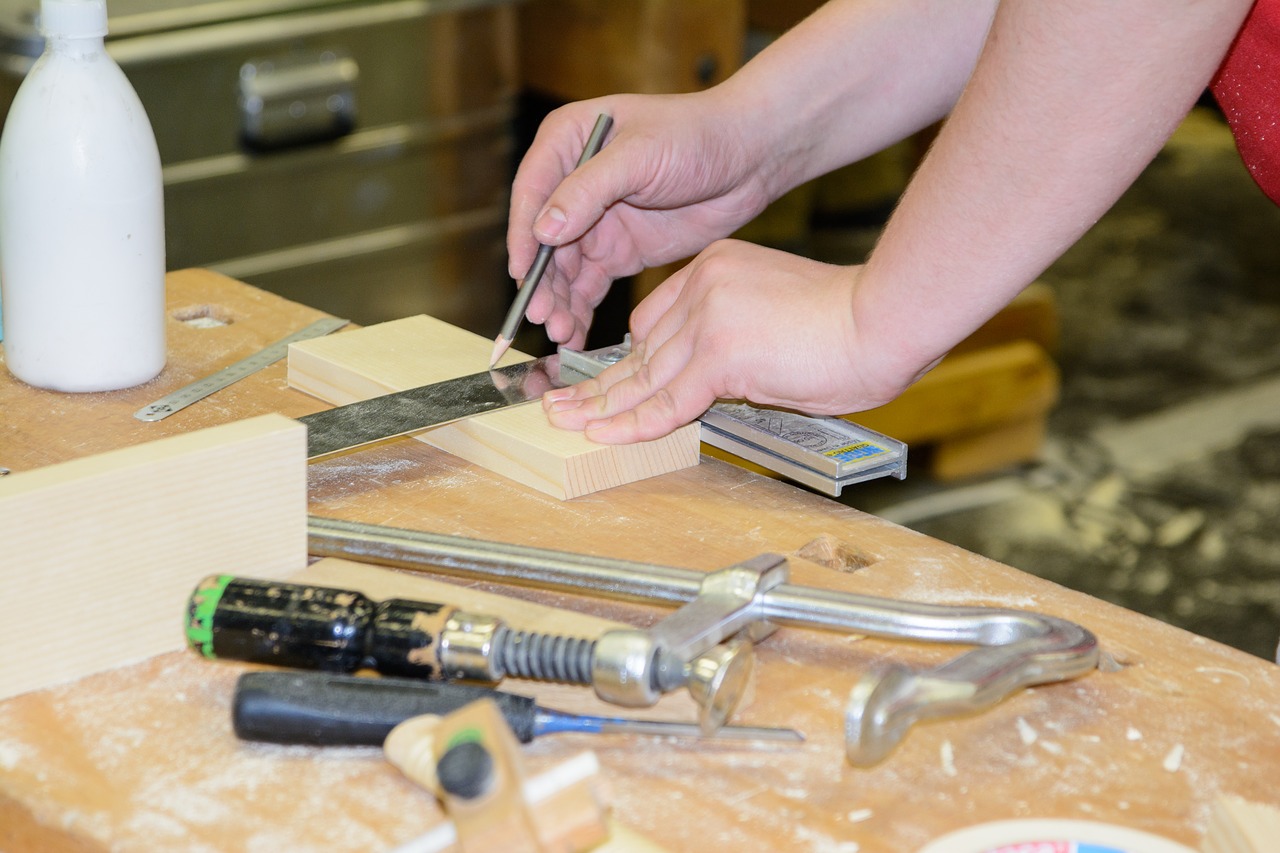What Tools Does A Carpenter Need?
If you’ve recently qualified as a carpenter then you’re going to need to stock up on tools before you can get to work. But don’t worry if you’re starting from scratch; everyone has to start somewhere. For many apprentices, using tools supplied by their employer would be the norm but as soon as you’re qualified, it’s time to start thinking about where your career will go. But what tools does a carpenter need?
Carpenters are responsible for installing timber fixtures on the worksite and this could be anything from staircases to shelving or furniture to flooring. Since this is such versatile work, you’ll also need a versatile tool kit and there’s no denying that a carpenter will have one of the most jam packed tool kits of anyone in the trade.
You’ll have learnt over the course of your training what the most essential items are but it can be handy to have a comprehensive list for reference and that is exactly what we will be providing in this guide. So, keep reading to discover the top most essential tools for carpenters.
Hand Tools
While it is important to have powered tools, especially in the modern workplace, you will need an array of hand tools if you want to work as a carpenter.
Tape Measure
One of the most important tools for any carpenter is a tape measure as this will ensure accuracy on any job. You’re going to need to choose one that measures at least 25 feet and this should be in retractable form. You could go longer but it may begin to be difficult to handle as well as challenging to roll back up. Of course, you could also purchase a laser measure which is very accurate but of course, will cost more.
Set Of Chisels
It would normally be a joiner that would use chisels as opposed to a carpenter but there may be times when you would need them. Anyone working with wood will benefit from these tools but it is essential to purchase a high quality set comprised of different sizes. The sizes should range between ¼ inch and 1 ½ inches. They don’t only allow you to carve wood but can also be used to clean out joints.
The best chisels are made from strong materials like carbon steel and feature a hardwood handle for added durability. You may also find handles that feature a metal cap which will prevent damage when using a hammer on them.
Along with your set of chisels, you will also need to make sure that you have stones for sharpening them. Many people would opt for a grinder but this doesn’t allow for as intricate honing. Using stones with varying grit will produce the best results.
Set Of Screwdrivers
If you were going to think of any essential tool for the woodworker, you’d likely think of a screwdriver but one just won’t do; you’re going to need a versatile set made up from different sizes and ends. But it’s not only important to look for versatility, you will want to choose a set of screwdrivers that is incredibly well made as these are tools you will get a lot of use out of.
Choose a heavy duty blade made from hard metal that won’t warp or bend the first time to give it some welly. It’s also a good idea to get some screwdrivers with a thin shank which will allow you to get into tight spaces; something you’ll often do on the construction site.
Claw Hammer
The claw hammer may be seen as one of the most basic household tools but it is also imperative in the tool kit of any decent carpenter. In fact, it’s one that you should never be caught without.
While you could be forgiven for thinking that choosing a hammer is as simple as selecting a loaf of bread, you would be wrong. A good claw hammer will have a perfectly balanced head with the claw counterbalancing the finished head. When the hammer is not balanced, you will find it far more difficult to control which can result in poorly driven nails; not what you want when you’re a professional.
When making a choice between claw hammers, you will need to think about the weight. Most would opt for a 20oz hammer as this has just the right amount of weight for both pulling nails out and driving them in. Finally, you should think about the material of the handle. Generally speaking, steel or fibreglass will withstand much more so offers greater durability whereas a wooden handle is kinder to your wrist.
Utility Knife
A utility knife is a multipurpose tool that no carpenter should be without. While it does serve many purposes, you will find that you use it a lot for cleaning out mortise joints.
Most of the time, these knives have a removable blade which can be disposed of when it becomes dull, eliminating the need to worry about sharpening.
Layout Square
Sometimes called a combination square, the layout square is essential in marking out square cuts on wood. They usually come in either a six or twelve inch size and while you could have both in your tool box, a lot of people opt for a six inch option purely for how compact it is. You’ll also want to think about the material from which the square is made; while they do come in plastic, these aren’t as robust so we would always suggest choosing a metal one.
They’re very easy to use and after you measure the length of your cut, you’ll line the square to the edge of the board allowing you to make a straight cut across the grain.
Handsaw
If you have any hand tool in your kit, it has to be a handsaw. While you will use powered saws, these versatile and easy to use pieces of equipment are a must. They can be used for rips and cross cuts and come in a range of teeth spacings making them suitable for a whole host of different jobs.
Power Tools
Any carpenter worth his or her salt will have a good collection of power tools that allows them to complete a variety of jobs quickly and efficiently
Circular Saw
Woodworkers need all different kinds of saws but the circular saw is definitely one of the most popular owing to how accurate they are when they are used correctly. The circular saw features a toothed disc set in a frame that spins around at high speeds to make the cut. They are especially useful for straight cuts.
That said, they can also be used for making a bevel cut if you are using a model that accommodates this making them rather versatile.
Circular saws are ideal for cutting a range of wood types and boards and what’s great is that they don’t cost the earth, even for a high quality model.
Drills
Drills can be mains powered or cordless and when working on a construction site, we would always recommend choosing a cordless drill for pure convenience. Modern battery powered drills are comparably powerful to their corded counterparts and have a range of options to make them very versatile.
You will need to think about the right type of drill and generally speaking, carpenters will use either a regular drill, an impact driver drill or a hammer drill although if you want to, there’s nothing stopping you having one of each.
Moreover, there is the option to change the drill bit which quickly converts the tool into a powered screwdriver; excellent when you’re in a push for time.
Jigsaw
Another of the most common tools that any woodworking professional needs to have is the jigsaw. This is a much more intricate piece of equipment than the aforementioned circular saw and is used to cut circles or round patterns. There are a lot of people who prefer to use a bandsaw which does a similar job but a jigsaw is far easier to use and a good choice for beginner carpenters.
Nail Gun
When you’re fixing timber items on the worksite, you are going to need to fix a lot of nails. Doing this by hand can be a very laborious task and will take far longer than when you are using a nail gun. If you’re looking to make your job easier, then this is one of the most essential power tools you will need to invest in.
Replacing the traditional hammer and nails, your nail gun uses powered force to drive in nails quickly and efficiently.
Power Sander
When it comes to choosing a sander, there are a few things to think about. For starters, there is more than one kind so it may be beneficial to think about the type of work you do. In many cases, carpenters will have both a palm sander and a random orbital sander to allow them greater versatility in the workplace.
When you are working in tight spaces, a palm sander is the obvious choice. You only need to use ¼ of a sheet of sandpaper so it’s also great for smaller projects. That said, these tools are very abrasive and owing to their motion, they aren’t suitable for the final finish on a product as it will leave unsightly marks like streaks and swirls.
You will also need an random orbital sander which is ideal for putting the finishing touches to a project. Unlike a palm sander, it does not move in a circular or back and forth pattern but rather, as the name suggests, randomly. This means that you get a much smoother finish without the risk of scratches or marks.
Moisture Meter
While not necessarily a power tool, the moisture meter is vital for anyone who works with wood, whether they are a joiner putting projects together or a carpenter fitting finished products onsite. If wood contains more than 7% moisture, it will warp as it dries which will leave the final product looking less than professional and there is a risk of cracking. This is why it is so important to make sure that wood is dry before working with it.
While the lumber mill will dry its wood, there is nothing to say that moisture won’t reenter the stock over its journey from mill to construction site. But knowing whether the wood is dry enough to work with cannot be left to chance which is why a moisture meter is so important. This tool will tell you how damp the wood is giving you a better idea of its suitability.
There are two different types of moisture meter; pronged and non-pronged. Pronged meters feature two prongs that penetrate the wood to take readings from inside. These are great for determining if there are any moisture pockets and are considered to be the most accurate. However, non-pronged meters require you to simply place the connectors onto the wood which many consider to be a simpler process. However, the readings might not be as accurate.
Conclusion
Being a carpenter means that you will need a wide variety of tools to do your job properly. From simple hand tools like the claw hammer and a decent set of chisels through to power tools such as drills and sanders, you’ll certainly have one of the most diverse toolkits of anyone in the trade!









